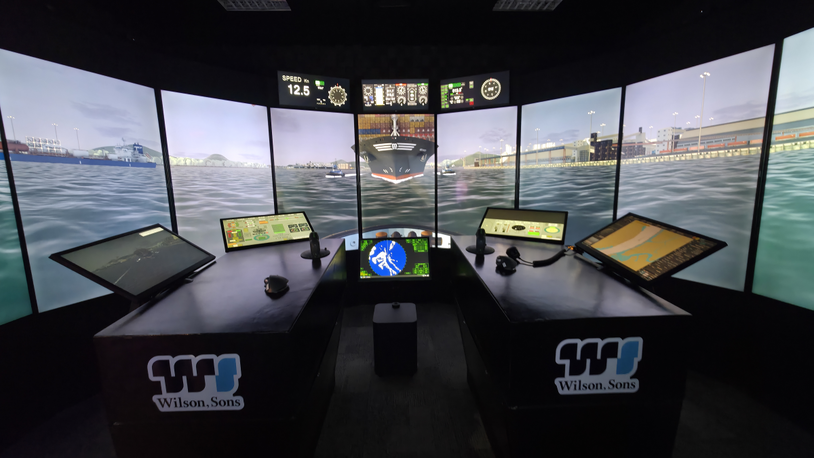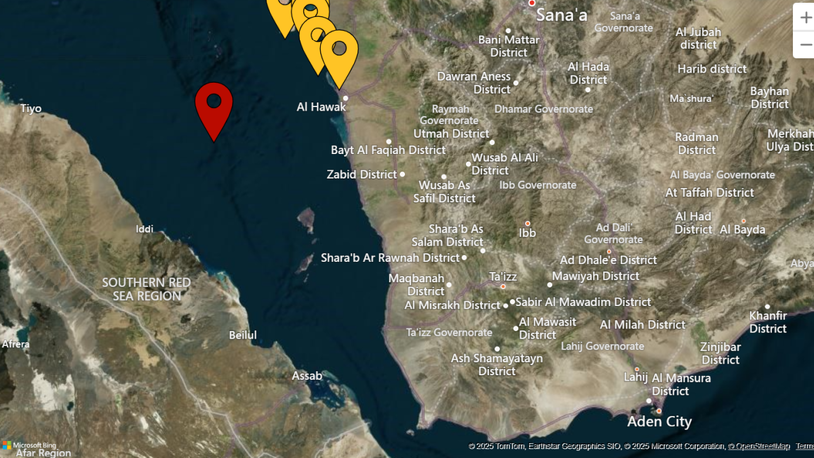Business Sectors
Events
Contents
Navigating safer seas: taking on rogue maritime drones
Using counter-drone technology based on RF cyber to safeguard ports, ships and offshore facilities against rogue drone threats
With its vast expanse of open waters and critical infrastructure, the maritime sector presents unique vulnerabilities to drone-based threats - as well as a complex landscape for drone defence. From operational disruptions and smuggling to espionage and terrorism, the maritime drone threat remains as varied as the operational environment itself.
According to Homeland Security (US), a US Department of Homeland Security report on maritime security challenges) noted that, “...security breaches involving drones around maritime ports and critical infrastructure ‘are becoming a common occurrence.’”
From an operational standpoint, rogue drones can interfere with critical command and control systems. A drone could be deliberately flown into sensitive areas of a vessel to target crucial navigation or communication equipment to render essential systems inoperable. Beyond this type of physical impact, drones carrying specialised equipment designed to emit signals that interfere with onboard systems, such as GPS jammers, can serve as platforms for electronic warfare. Drones can also be utilised in more complex cyber attacks, such as GPS spoofing, where false location data is transmitted to the vessel to cause navigational errors, or to broadcast fake Automatic Identification System (AIS) signals, which creates phantom vessels on ship radars to complicate situational awareness for crew members. This type of drone interference at offshore oil rigs or other marine installations could lead to catastrophic consequences, including to the environment.
Drones can also become tools for smuggling drugs, weapons and other contraband over waterways, at ports or onto ships. Just this year, for example, smugglers used drones to transport drugs across the Niagara River from Canada to New York.
Using a house in Youngstown as the drop point, three suspects used a drone to carry 3 kg of MDMA (so-called Ecstasy) in multiple cross-border flights, before they were apprehended by local authorities.
Ships, ports and bases vulnerable
Sensitive areas within ports and on ships further remain vulnerable to drone-based espionage. In late 2023, at the naval base in Norfolk, Virginia, officials observed multiple unauthorised drones hovering near sensitive areas of docked military vessels. The assumption is these drones were being used to gather intelligence.
Add to these concerns the threat of drone-enabled terrorist attacks on ships, ports, or offshore installations. For example, weaponised drones can loiter in the vicinity of potential targets, await the opportune moment, and then launch an attack. Drones have already demonstrated their destructive capabilities in real-world scenarios in attacks on vessels traversing the Strait of Hormuz.
These wide-ranging scenarios demonstrate the diverse and serious nature of drone threats in maritime environments.
Unique challenges in addressing maritime threats
Traditional counter-drone systems, such as radar, surveillance cameras and surface-to-air missiles, often fall short in the unique maritime environment. Their challenges range from visibility issues and an inability to distinguish between objects during the detection phase of a counter-UAS operation to potential collateral damage in the mitigation phase.
The vast expanse of open ocean, combined with the presence of other vessels, can obscure detection of potential rogue drones. Nighttime and adverse weather conditions further reduce visibility and exacerbate this problem.
In the maritime environment, conventional systems often struggle to differentiate between small drones and other flying objects, such as seabirds. This can lead to a high rate of false positives, which can overwhelm operators and reduce overall system reliability.
Mitigation
When it comes to mitigation, the shortcomings of traditional approaches become even more apparent. Kinetic solutions, which attempt to physically disable or destroy rogue drones, pose significant risks in a maritime setting. The potential for collateral damage to the ship, crew members or surrounding marine life poses a critical concern. Missed shots or falling debris could have catastrophic consequences.
On the other hand, jamming techniques, while potentially effective in the short term, come with their own set of problems. While the use of jamming technology can be temporary, it may inadvertently disrupt critical ship communication and navigation systems. Such disruptions can compromise the safety and operational capabilities of the vessel itself.
These limitations underscore the need for more sophisticated, tailored counter-drone solutions in the maritime environment that can address the unique challenges posed at sea, while also ensuring the safety and continuity of maritime operations.
A sea change in solutions
A new-generation counter-drone technology, based on radio frequency cyber (RF-cyber) takeover, such as that pioneered by D-Fend Solutions in their EnforceAir C-UAS system, has been specifically tailored to overcome the hurdles of countering drones in the maritime setting. One of its key advantages in maritime applications is its ability to detect and mitigate rogue drones across all maritime environments. Whether deployed on a small vessel or scaled up for larger platforms, the system’s compact design and ruggedised construction make it ideal for the harsh conditions encountered at sea. Its omnidirectional antenna provides full 360° coverage to eliminate blind spots in drone detection.
In an industry where drones are increasingly used for legitimate purposes such as ship inspections, cargo monitoring and environmental surveys, the system’s ability to differentiate between authorised and unauthorised drones remains a crucial feature. RF-cyber’s precise identification ensures these beneficial drone operations can continue unimpeded while still maintaining a strong defence against potential threats.
The system’s advanced detection capabilities can also distinguish small drones from other flying objects. This reduces the false positives that often plague radar-based systems. This precision is invaluable in the complex maritime environment where birds, debris and various vessels can create a cluttered detection landscape.
The adaptability of RF-cyber to various maritime platforms further enhances its value in maritime defence strategies. From small patrol boats to large container ships, and from offshore oil rigs to coastal defence installations, the system can be configured to meet specific operational requirements. The system’s integration capabilities allow it to seamlessly interface with existing security infrastructure to form part of a multi-layered defence approach. Its low power footprint also allows for such integration without placing undue strain on power resources, a key consideration for vessels that may be at sea for extended periods. In an industry where vessel types and missions can vary widely, this flexibility and interoperability ensures maritime operators can leverage their current investments in security technology, while adding a crucial counter-drone capability.
With regard to mitigation, RF-cyber’s effectiveness stems from its innovative approach. Unlike kinetic solutions that risk collateral damage to ships, crew or marine life, or jamming techniques that may interfere with critical ship communications and navigation systems, RF-cyber employs a more sophisticated method. The system uses radio frequency cyber takeover technology to assume control of rogue drones, safely landing them or redirecting them to a predefined safe zone.
This non-kinetic approach proves particularly valuable in maritime settings where the consequences of a mishandled drone incident could be catastrophic. Imagine a scenario where an official detects a suspicious drone approaching a busy port. Traditional methods might involve attempting to shoot it down. This risks debris falling on ships or port infrastructure. An RF-cyber based C-UAS could take control of the drone and guide it to a secure area for inspection, without disrupting port operations or endangering personnel.
Finally, RF-cyber’s effectiveness in maritime environments is not just theoretical. Its maritime prowess has been conclusively demonstrated in real-world scenarios. During a comprehensive week-long port exercise, the technology exhibited exceptional capability in managing complex, multi-drone threats. The demo, which brought together a coalition of leading security providers, including D-Fend Solutions, Liteye Systems, Numerica Corp and Romeo Papa Boats, aimed to validate the efficacy of an integrated, multi-layered ship-based counter-UAS system in protecting vital supply routes and port facilities. The EnforceAir RF-cyber system contended with numerous UAS threats, including drones observed near vessels and installations in New Orleans. The seamless integration of Liteye’s camera systems, Numerica’s radar technology, and EnforceAir’s proprietary solution proved to be a comprehensive defence network. This integrated approach enabled rapid threat identification, real-time visual tracking of both drones and operators and significantly enhanced maritime domain awareness. This successful demonstration validated RF-cyber’s role as a crucial component in modern port and maritime security strategies.
Fair winds and following seas
Over the horizon, in the maritime environment, the drone threat landscape will continue to extend beyond mere nuisance to potential espionage, smuggling or terrorist activities. RF-cyber’s innovative approach to detection and mitigation, coupled with its maritime-specific features, can provide a comprehensive solution to the complex challenges faced by ports, ships and offshore facilities. Its deployment on ships and in ports can provide a crucial layer of defence against these evolving threats.
RF-cyber addresses the unique threats and overcomes the limitations of traditional C-UAS systems. The RF cyber takeover technology provides a safe alternative to kinetic solutions that risk damaging ships, injuring crew, or harming marine life. This approach allows for the controlled landing or redirection of rogue drones without disrupting critical ship systems. RF-cyber does not just protect assets. It safeguards the entire maritime ecosystem.
As we continue to navigate the future of maritime security, RF-cyber may very well emerge as a key potential tool in the arsenal of maritime operators… to ensure safer seas and skies for all.
Dawn Zoldi, Esq, and Colonel, US Air Force (Ret), served for 28 years in the US Air Force. She is a licensed attorney and founded P3 Tech Consulting to connect people with a passion for advanced technology platforms with the information they need to succeed. An internationally recognised expert on uncrewed aircraft systems and advanced air mobility law and policy, Ms Zoldi is the author of Unmanned Aircraft System Legal and Business Considerations.
Related to this Story
Events
Offshore Support Journal Conference, Americas 2025
LNG Shipping & Terminals Conference 2025
Vessel Optimisation Webinar Week
© 2024 Riviera Maritime Media Ltd.














